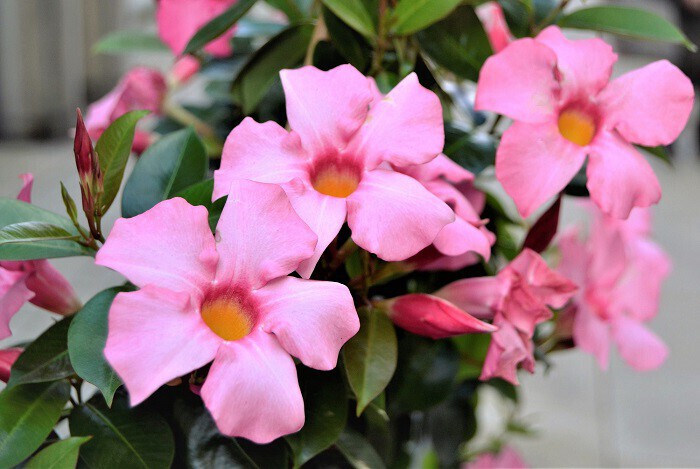These tropical climbers are easier to grow than you'd think.

If you're looking for a way to add a pop of color to your garden, consider the mandevilla plant. The climbing, flowering vine can bring rich pinks, yellows, and reds to your garden bed while also adding height and depth. We spoke with garden experts to learn everything you need to know in order to successfully grow one in your yard this summer.
What is a mandevilla plant?
Mandevilla is a tropical, flowering vine that has become popular in landscapes and in pots on decks, patios, and porches thanks to its colorful flowers, long bloom time, and low-maintenance characteristics, says Justin Hancock, a Monrovia horticultural craftsman. "The flowers come in rich, jewel-tone colors; appear continuously; are often attractive to pollinators like bees, butterflies, and hummingbirds." Hancock says the mandevilla can make a beautiful centerpiece when planted alone in your garden or become a stunning addition when mixed in with other summer plants.
Growing Mandevilla Plants
As with any plant, the first tip for success is to make sure you find the right spot for it to flourish. "Mandevilla love the sun, so a spot with all-day sun is best," Hancock explains. "They'll tolerate a spot with morning shade and afternoon sun, but they may not bloom as profusely." To get the best results from your mandevilla, he suggests planting them where the soil dries a bit between watering.
If you have a vining mandevilla, you'll need to give it a support to climb on. "It climbs by wrapping its stem up and around a support, so it's good for trellises, wire, and so forth," he says. "It won't be able to grow up a flat wall since there's nothing to wrap around." That is, unless you have a mounding variety, which he says will grow in a tidy little mound without the need of a trellis or other support. "They might top out around 18 inches tall and wide or so by the end of the summer," he explains. "A vining variety, however, can climb 10 feet or more (depending on the climate) and needs a trellis or something, otherwise it will just crawl on the ground."
How to Care for Mandevilla Plants
Fortunately, mandevilla plants aren't too fussy when it comes to soil. "If you grow it in a pot or planter, look for a quality potting mix or potting soil," he says. "Don't use topsoil as [the plant] typically doesn't drain well in a pot and [it] can cause root issues." If you've decided to add your mandevilla directly into your garden bed you will want to make sure it is planted in an area that drains well, otherwise, Hancock suggests mounding up the dirt around it so that you can manufacture better drainage. Remember: your mandevilla would rather be a bit too dry than a bit too wet.
How to Decorate Using Mandevilla
After you've gotten the hang of growing a mandevilla, you might decide you want to bring some of those beautiful blooms inside. According to Michelle Edgemont, owner of Michelle Edgemont Design, you can cut a few flower stems off every once and a while to decorate your home. "The stems are thin and wild," she says. "Style them in a trio of bud vases on your dining room table." If you have an area with some height, you can cut the stems longer to create a draping effect (like off the corner of your mantel). Have a small space? Edgemont says you can snip some blooms to add a bright pop of color to a powder room sink, or other small area. "If the cutting starts to root, you can transplant them into a pot with soil," she says. "Place in a sunny spot outdoors near a rail for it to climb."